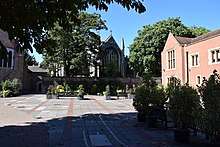Old Palace School
The Old Palace of John Whitgift School is a selective independent school for girls in Croydon, London. The Old Palace is protected as a Grade I listed building.[1]
| Old Palace of John Whitgift School | |
|---|---|
 | |
| Address | |
Old Palace Road , , CR0 1AX England | |
| Coordinates | 51°22′22″N 0°06′18″W |
| Information | |
| Type | Independent school |
| Motto | Latin: Pro Ecclesia Dei (For the Church of God) |
| Established | 1889 |
| Founder | Order of the Community of the Sisters of the Church |
| Department for Education URN | 101846 Tables |
| Headmistress | Jane Burton |
| Gender | Girls |
| Age | 4 to 18 |
| Enrolment | c. 870 |
| Houses |
|
| Colour(s) | Green and Purple (formerly Brown and Green) |
| Affiliation | Whitgift Foundation |
| Alumni | Old Palace Old Girls |
| Website | www |
It consists of a nursery for the ages of 2-3, a preparatory department for the ages of 4-10 and a senior school for pupils aged 11–18. The school is operated by the Whitgift Foundation, along with Whitgift School and Trinity School of John Whitgift.
History

The school was founded in 1889 by the Sisters of the Church. The "Old Palace" itself was for 500 years the summer residence of the Archbishops of Canterbury. In the 19th century the Archbishops ended their residence at Croydon Palace and used Addington Palace, also in Croydon, instead. The Palace was sold and subsequently used as a bleaching factory, amongst other things. The building was rescued by the Duke of Newcastle in 1887 and given to the Sisters Of The Church who used it for educational purposes.
In 1945, the school became a Direct Grant Grammar School and in 1975, became a fully independent day school for girls. The school joined the Whitgift Foundation in 1993.[2] The school merged with Croham Hurst School, a former independent school, in 2008.[3] It is also home to a suspected ghost - The Green Lady - who was said to have lived there around the time of Queen Elizabeth I.
Grounds
The school building was for centuries the summer palace of the Archbishops of Canterbury. It began life as the manor house, part wooden from at least the 12th century, and stone from the 14th century. The core of today’s palace was built in the 15th century. The guardroom – once a reception room, now a library – dates from the time of Archbishop Thomas Arundel (1396-1414), and is one of the earliest uses of brick in Britain. Archbishop John Stafford (died 1452) built what is now one of the finest medieval great halls left in southern England. A number of monarchs from Henry VI to Elizabeth I banqueted under its high arched-brace roof, each sitting on Stafford’s stone throne, part of which survives against the west wall. Elizabeth made numerous visits, and her bed, always travelling with her, was set down in what is now known as Queen Elizabeth’s room, a large 15th-century first-floor space, with moulded ceiling joists. The chapel dates from the 15th century, and includes a gallery pew in dark oak often referred to as ‘Queen Elizabeth’s Pew', built by Archbishop William Laud. Beneath this is a Norman font gifted in Victorian times from St George’s Church, Southwark, the same font where Charles Dickens had Little Dorrit christened.[4]
The school also houses modern, purpose-built facilities including seven laboratories, a heated indoor swimming pool, and an Art and Technology building. In 2001 a building for the Junior Department and one housing the Sixth Form and P.E. area were opened. The school also benefits from access to Whitgift Foundation grounds and facilities.[5]
Notable alumni
- Jane Featherstone - Television Producer[6]
- Sarah Jones - Labour MP for Croydon Central from 2017[7]
- Helen Young - weather forecaster and television presenter[8]
Houses
All students are assigned to one of four houses named after notable people associated with the Palace. The houses, and their colours, are Anselm (yellow), Hatton (green), Laud (purple), and Stafford (blue).
References
- Old Palace School (Croydon Palace) - Croydon - Greater London - England | British Listed Buildings
- "Archived copy". Archived from the original on 2013-07-31. Retrieved 2013-08-10.CS1 maint: archived copy as title (link)
- "Croham Hurst School Website".
Thank you for visiting www.crohamhurst.com. Croham Hurst School has merged with Old Palace of John Whitgift School. Go to the Old Palace of John Whitgift School website
- "Old Palace of John Whitgift School". Oldpalace.croydon.sch.uk. Retrieved 2017-02-21.
- Old Palace of John Whitgift School, Croydon, Surrey
- "What's the future for drama? Spooks & The Split producer Jane Featherstone reflects". Royal Television Society. 20 April 2018. Retrieved 13 March 2020.
- Carr, Tim; Dale, Iain; Waller, Robert (2017). The Politicos Guide to the New House of Commons 2017. Biteback Publishing. ISBN 978-1-78590-278-9. Retrieved 12 March 2020.
- "Helen Young". Rotary Clubs of Great Britain. Retrieved 13 March 2020.